developmental psychology ch11
1/34
Earn XP
Description and Tags
Name | Mastery | Learn | Test | Matching | Spaced |
|---|
No study sessions yet.
35 Terms
Parenting:
Good parenting takes time and effort.
→ Appx. 50% of fathers and 25% of mothers feel like they’re not spending enough time with their children
→ Both mothers and fathers spend more time with their kids than the previous generation of parents.
Not just quality of time spent with children important for children’s development - quality matters too: maternal scaffolding, sensitivity, and support for autonomy linked to better executive function in preschool children.

Healthy families:
They are demanding (rules) and responding (warmth), kids with authoritative parents were more academically successful, well-adjusted and kind.
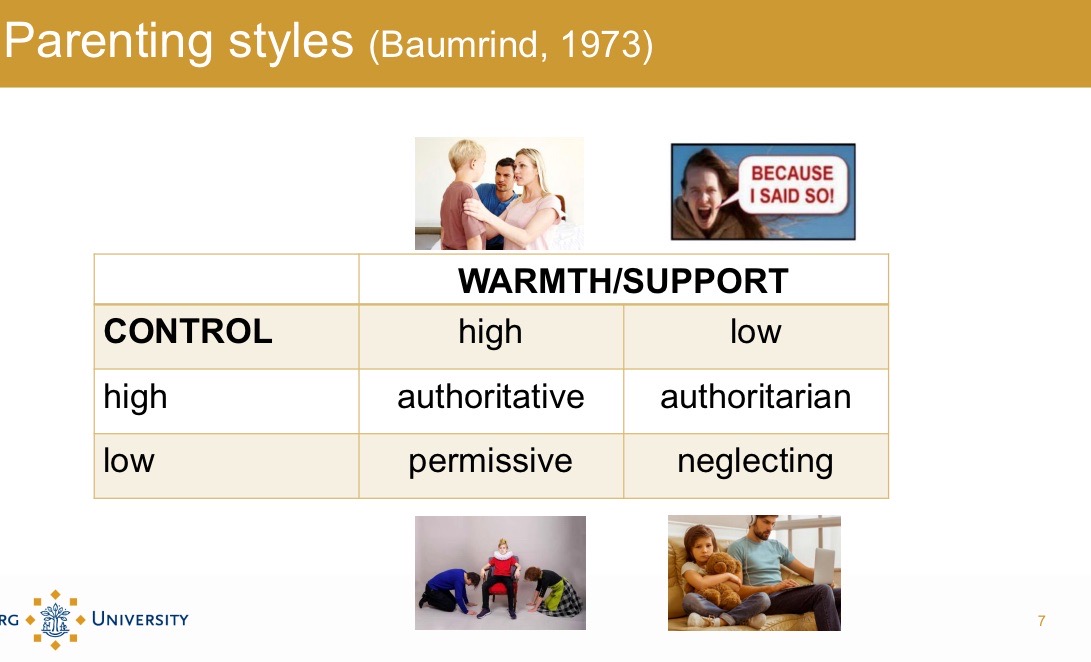
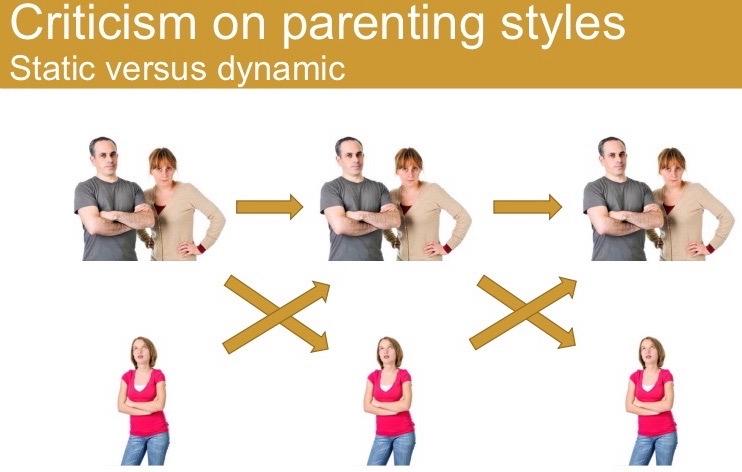
Criticism on parenting styles:
Static vs dynamic → parenting is less static and more bidirectional and child-evoked than Baumrind assumed.
The effect of parenting styles can differ between kids:
N = 259 adolescence and 188 parents
Longitudinal study over 1yr with 26 biweekly parenting and well-being questionnaires.

Criticism on parenting styles - cultural differences:
Baumrind’s perspective = Western middle class perspective
Individualistic cultures emphasise autonomy, self-reliance, interest - more authoritative
Collectivistic cultures emphasise interdependence and needs of others - authoritarian
Cultures differences in parenting in NL: 2nd generation Turkish immigrant families → Turkish mothers were less supportive and less authoritative and more intrusive than Dutch mothers
Factors influencing parenting styles
Genes
How their parents were raised
Socioeconomic conditions and education - low SES; more emphasis on obedience and respect for authority
Environment - dangerous - obedience
Culture - respect for parents important - more authoritarian
Helicopter parents
= developmentally inappropriate levels of control and assistance - overparenting
Micromanagement of children’s life - closely monitoring activities, mainly authoritative parents, sometimes authoritarian
Effects on child - negative self-perceptions, self-efficacy, prone to xanax overuse, high levels of narcissism, poor coping, low self-perceived autonomy, more depressed, lower life satisfaction.
Moderators - helicopter parents:
→ Informant: Positive effect in parent - reporting of helicopter behaviour.
Well-intentioned parents think it’s beneficial, but not adolescent reporting.
→ Gender effect for helicopter fathers, negative effect for helicopter moms.
Maybe fathers less involved - sign of care?
Diverse family experiences: Siblings
Young children’s reaction to new sibling: mothers typically pay less attention to firstborns after a new baby.
→ Firstborn can become more demanding, more dependent and clingier.
May develop problems with sleeping, eating, and toilet activities, possibly new insecure attachment.
Most firstborns adapt well, minority have difficulty coping.
Sibling rivalry:
= normal part of sibling relationships.
Characterised by closeness/conflict.
Sibling relationships friendlier and less conflicted if parents get along and respond warmly/sensitively to their kids.
Children accept the differences in treatment if age based.
Silblings: Influences on Development
Emotional support: Brothers and sisters confide in one another, often more than in their parents, protect and comfort one another
Caregiving: Siblings babysit and tend young children
Teaching: Siblings feel a special responsibility to teach, and younger siblings actively seek their guidance
Social experience: In interactions with siblings, especially skirmishes, children learn how to take others' perspectives, read others' minds, express feelings, negotiate, and resolve conflicts → can have positive effects on social cognitive skills and social competence.
also negative effects possible, ex. influence one another to use drugs
Sibling relationship quality and psychopathology:
More sibling warmth, less sibling conflict and less differential treatment significantly associated with less internalizing and externalizing problems
Largest effect sizes for sibling conflict
Effect sizes moderated by:
sibling gender combination (higher percentage brother pairs)
age difference between siblings (smaller age differences)
developmental period (children than for adolescents)
Besides parent-child and marital relationships, sibling context important for psychopathology.
Gay and lesbian familities:
Relationships usually egolitarian, share of responsibilities, division of labour based on who can do the task better/easier.
Parenting: both involved, biological one usually leading
Effects on development of a child → Effective parenting at least as likely as for hetero.
Lesbian moms hit less, more imaginative and domestic play, otherwise similar to hetero
Better than single mom developmentally, same to hetero
Sexual orientation of children similar to hetero parents.
Divorce: statistics
Note that decrease in total numbers is related to lower number of marriages.
Over lifetime of marriages about 50% of marriages are getting divorced.
Large proportion involve children.

Divorce: Consequences
Academic problems
Externalizing problems
Take drugs
Less socially responsible/intimate
Sexually active earlier
Antisocial peers
Less securely attached, but large differences
Majority of children (75%) don’t have significant adjustment problems - do well in school
Interpretation problems:
Third confounding factor? Lower finances, fights, shared genes, higher degree of conflict.
Should parents stay together for the sake of kids?
Conflict in non-divorced families associated with emotional problems in kids - it can errode well-being.
a) Move to divorced, single parent families might reduce conflicts and thus enhance well-being of kids → Divorce can be advantageous
b) Diminished resources and increased risks associated with divorce might be accompanied by sustained or increased conflict → Remaining married better
→ Difficult to determine “ifs”
Preventing negative effects of divorce:
Adequate financial support
Good parenting by both parents
Minimal parental conflict
Additional social support
Minimal other changes
Personal resources - intervention programs

Reconstituted families:
With time, children adjust well in a simple stepfamily.
Function well compared with kids in conflictual non-divorced/complex families.
>75% of adolescents in long-established simple stepfamilies described relationships with stepparents as “close” or “very close” → Not family structure, but good parenting!
Children maltreatment:
Physical abuse
Sexual abuse
Emotional abuse
Child neglect (physical, emotional) → most common
Types can be found separately, but often occur in combination.
Emotional abuse almost always present when other forms identified.
Prevalence childhood sexual abuse varies: for men and women
Prevalence in men might be higher than reported
Lower likelihood of reporting SA - fear of gay stigma
Poorer recognition of sexual abuse
For different countries: research in South Africa: all high prevalence
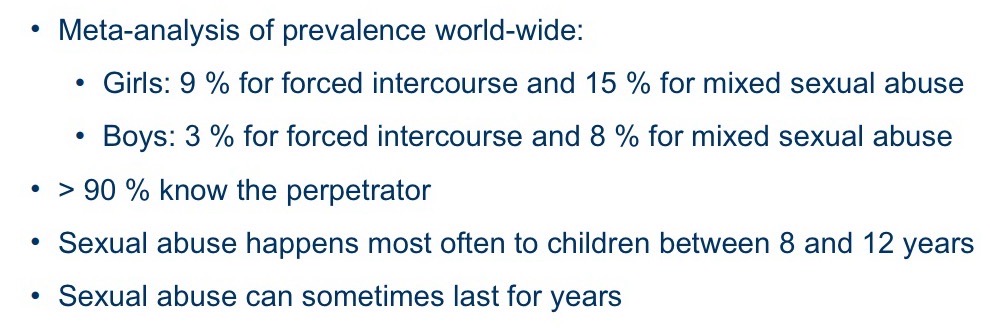
Prevalence of child abuse:
About 119.00 children per year in the Netherlands
About 1 child per classroom (of 30 students)
Statistics vary depending on who you ask (self vs informants reports)
Another issue with statistics: grey zone
Potential consequences of child maltreatment: Biology
Structural changes in maltreated children: reduced prefronal cortex volume (PFC important fro higher cognitive functions and emotion regulation)
Duration matters: different brain areas develop at different pace.. but large individual differences

Potential consequences of child maltreatment: All areas
Emotion dysregulation (underregulation and/or overregulation)
Attachment problems
Lower social competence (withdrawal and/or aggression) → relationship problems
Lower self-esteem
Lower school performance
Personality pathology: E.g. borderline personality disorder, anti-social PD
Posttraumatic stress disorder (PTSD)
Internalising problems (anxiety, depression)
Externalising problems (aggression, delinquency, substance abuse)
Sexual problems (in case of sexual abuse) or sexual risk taking
Suicidal ideation and attempts
Increased risk for diabetes, lung disease, malnutrition and vision problems
Resilience:
Dynamic development process where a positive adjustment takes place despite traumatic events/severe setbacks.
Resilience - different theoretical models: Challenge model
Moderate adversity leads to better adaptation that no ot extreme adversity.
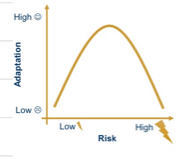
Resilience - different theoretical models: Depletion model
Adaptive function stable until adaptive capacity is depleted, after which is declines sharply
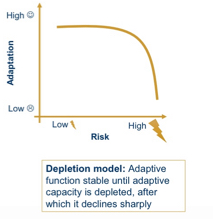
Resilience - different theoretical models: Compensation factor
Characteristic A enhances adaptation regardless of risk - Main effect

Resilience - different theoretical models: Protection factor
Characteristic protects especially in the face of high adversity: Main + Interaction effect
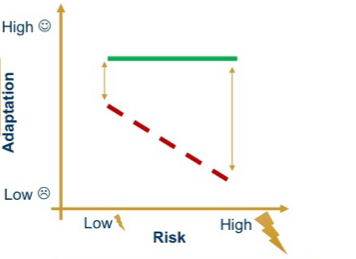
Resilience - different theoretical models: Diathese stress model
Vulnerability factor: Characteristic A increases vulnerability at high risk.
Resilience - different theoretical models: Differential susceptibility model
Context-sensitive factor: Characteristic is beneficial at low risk, but detrimental at high risk.
Resilience - Adaptive Processes
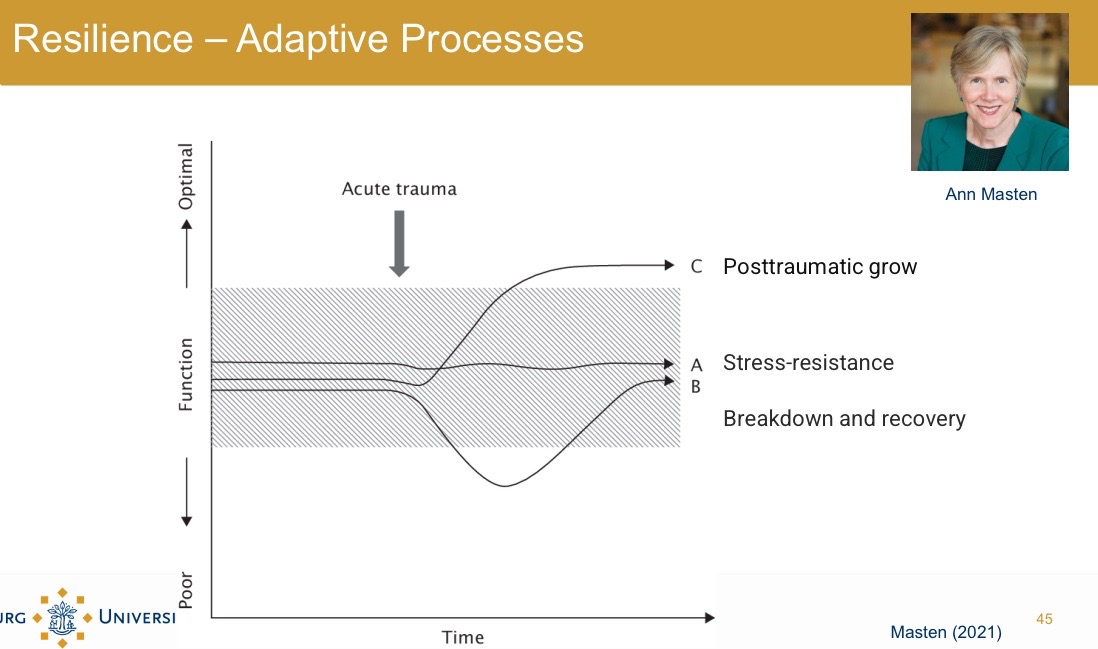
Resilience: Core characteristics within child
Talented, many activities
Have good social/intellectual skills, self-regulation
Have at least one close, caring relationship
Optimistic worldview/internal control/self-efficacy
Faith/sense of meaning
Genes
Household wit structure and support
Resilience: factors
Research showed that parenting matter more than genes: with good environment kids grow up to express their genetic fate
Peers matter: Harris - Socialisation to become adults is facilitated by peers more than parents, Brofenbrenner → Many influences
Resilience: Longitudinal study
People with a history of some lifetime adversity reported better mental health and well-being than not only people with a high history of adversity, but also than people with no history od adversity.
What doesn’t kill you makes you stronger - in small dose and type of adversity dependent
Resilience: kids of a depressed parent
What determines resilience in these adolescence?
Resilience: absence of mental disorder, subthreshold symptoms or suicidality at all three study time points.
53 out of 262 adolescents were classified as resilient:
Protective factors:
Support from co-parents, good social relationships, self-confidence, frequent physical activity - the more the better